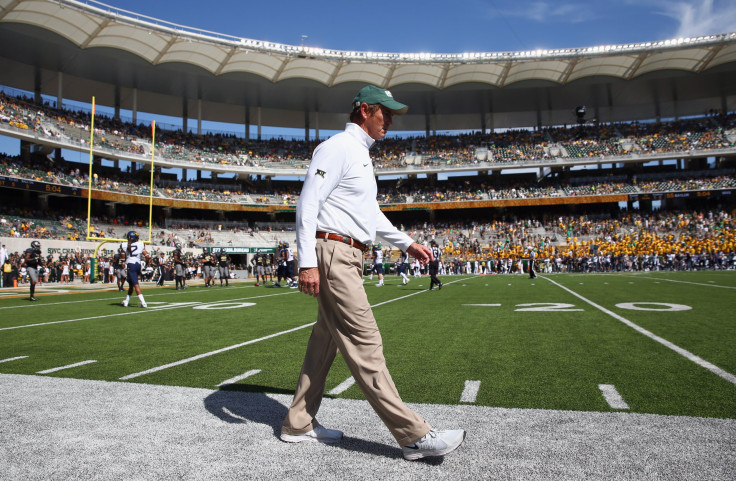What's Football Worth To Baylor? Fired Coach Art Briles Built Massive Program At Center Of Sexual Assault Scandal

When Baylor University football kicks off its season Sept. 3 — playing in a $266 million, 45,140-capacity shrine to the program — one person will be notably absent. After an investigation found a "fundamental failure" in the Waco, Texas, school's handling of sexual assault allegations against its football players, head coach Art Briles was suspended with intent to terminate Thursday.
The scandal also resulted Thursday in the resignation of Kenneth Starr, the former federal jusge, solicitor general and Bill Clinton special prosecutor, as Baylor's president. He will stay on as chancellor.
Briles took over as the Bears' coach in 2008, the team having gone 12 seasons without a winning record. The now 60-year-old turned the program around, going 65-37 over eight seasons with two regular-season Big 12 conference titles.
But while the football product improved — and grew in value — multiple cases of sexual assault accusations were found to have been mishandled. The internal investigation on Thursday laid bare a culture in which the school didn't comply with federal statutes like Title IX and the Violence Against Women Reauthorization Act of 2013. And Baylor is just the latest case in a series of intersections between big-time college football and allegations of sexual assault.
Per source, here is the group text that Art Briles sent his players today #Baylor pic.twitter.com/4yGb1HLX1L
— Jessica Morrey (@JessicaMorrey) May 26, 2016
In the past few years, at least two former football players at Baylor were convicted of sexual assault, according to the New York Times. A report last week from ESPN's Outside the Lines detailed that some university officials and coaches knew of a number of sexual-assault and domestic-violence allegations — many of which involved football players — that stayed largely out of public view, and the players went undisciplined. But while the Baylor football program under Briles fostered this culture of "fundamental failure," it was also worth a ton of money to the school, as the coach built up a winning team that boosted the value of the program.
According to January 2016 valuations published in the Wall Street Journal, Baylor's football program was worth $89.69 million. The valuations performed by Ryan Brewer, assistant professor of finance at Indiana University-Purdue University Columbus, analyzed "each program’s revenues and expenses and made cash-flow adjustments, risk assessments and growth projections to calculate what a college team would be worth on the open market, if it could be bought and sold like a professional franchise."
Baylor football's revenue wasn't listed in the 2016 valuations, but in 2015 the figure was pegged at $40,400,043. The school reported that athletics account for 8 percent of its total revenue, but it's safe to assume the lion's share of that revenue comes from football.
The university is not falling off a revenue cliff anytime soon, since its conference, the Big 12, can lean on a $2.6-billion TV contract that runs through 2024-2025 season. But with this scandal, the football program could certainly suffer — at least one recruit has seemingly indicated he's re-examining his commitment to Baylor — which could affect its value. And programs can quickly cost more than they bring in.
U.S. News and World Report wrote in January:
"But for all the benefits, monetary and otherwise, of college football, there are downsides — the high costs of the programs, fees paid by students, injuries to players and one new concern from a recent study: increased sexual assault on college campuses."
The article cited a study that found reports to law enforcement of rapes where the victims are 17 to 24 years old increase by 28 percent during Division 1 football games.
To be sure, Baylor is far from the first college to have its football team embroiled in such a situation. Mother Jones tracked 40 years of such cases through 2013 and this site has tracked a decades-long, comprehensive list through August 2015.
Meanwhile, a 1998 study found that male athletes charged with sexual assault are more likely to avoid being convicted than other men. According to Justice Department statistics, 32 percent of rapes reported to police in 1990 resulted in arrest — more than 54 percent of those arrested were convicted. Meanwhile, of the 217 felony rape complaints made to police that involved athletes between 1986 and 1995, 79 percent resulted in arrests. But just 31 percent of the 172 athletes arrested were convicted.
© Copyright IBTimes 2024. All rights reserved.






















